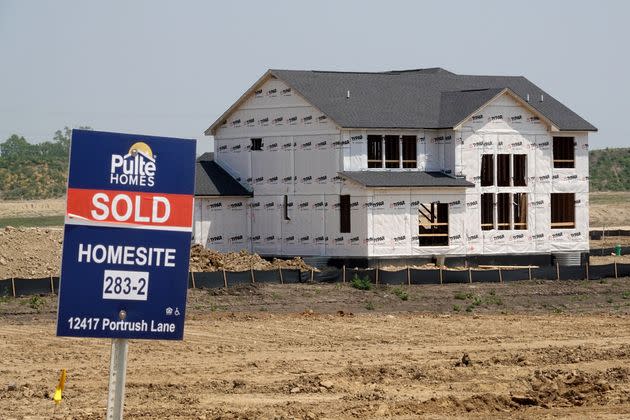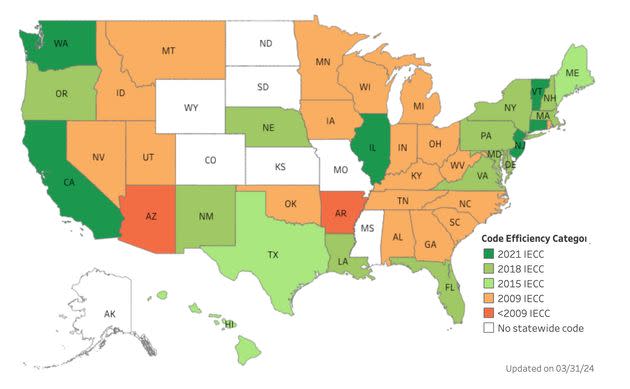GOP Ramps Up Effort To Block Biden Rule That Saves Americans $2 Billion On Energy
The “real people” facing the “real consequences” of a Biden administration policy designed to reduce Americans’ utility bills by $2 billion are surreally photogenic.
Thanks to a new federal rule requiring newly built homes to meet higher energy efficiency standards to qualify for federal loans, Noah, the smiling paralegal from Atlanta, can’t afford the home he wants to buy. Neither can Keith, the bearded West Virginia schoolteacher whose dream house is now appraised at an eye-poppingly higher value because of the regulation. Nor can the LaMontes, charming-looking newlyweds “trying to start a new family in Columbus, Ohio.”
That’s according to testimony on the website of the Leading Builders of America, one of the nation’s two largest lobbying organizations representing the home-building industry. The claims are debatable, based at least in part on calculations advocates say inflate the costs of constructing homes to meet the latest and greenest ever building codes in the United States.
The portraits depicting the supposed homebuyers are all stockphotographs. (The LBA said “the numbers used in the testimonials are based upon real scenarios” but admitted “actual buyers” have yet to be “affected.”)
Yet the industry’s campaign to roll back one of President Joe Biden’s least understood but most effective policies to simultaneously slash planet-heating emissions and soaring energy bills is very real ― and it’s just getting started.
At issue is a regulation finalized in April that saw the federal government formally adopt the most energy-efficient national building codes ever published by the International Code Council, the private nonprofit whose codebook is used as a benchmark for most of the United States.
While building codes are set on the state and local level, the federal government lends money to homebuyers through various agencies. Under federal law, regulators at the Department of Energy are required to analyze the ICC’s latest codes when the third-party organization updates its codebook every three years. If the agency experts determine that the codes actually save energy, officials at the Department of Housing and Urban Development and the Department of Agriculture are tasked with confirming whether complying with the codes would raise housing prices by too much. If not, then the two agencies are supposed to update the eligibility criteria for their loan programs to make meeting the latest codes the minimum home energy standard for newly constructed houses.

The regulation does not mandate renovations or any changes to existing homes. It just means real estate developers who want to sell new homes to buyers who qualify for some federal financing need to make sure those houses and condos meet the most basic modern standards for insulation and windows. The rule does increase the upfront construction costs of a new home by anywhere from a few hundred to a few thousand dollars.
But federal researchers say those costs are spread out over the course of the mortgage on a home that’s less drafty and therefore commands a higher value. Either way, with Americans’ utility spending surging to record levels, study after study suggests the added efficiency typically pays for itself in cheaper monthly energy bills within just a few years.
“It’s painful for Mr. and Mrs. South Dakota Builder, but it’s going to result in better South Dakota homes,” said Robin LeBaron, president of Pearl Certification, a company that validates energy savings from renovations in homes.
Since the Mount Rushmore State has no enforced statewide code in place, builders may “have to adopt new construction practices.”
LeBaron recently worked with federal regulators to come up with a formula for calculating what it takes for homes to be “net-zero emissions.” By contrast, he said, meeting the ICC codes issued in 2021 amounted to just an incremental step forward.
“There doesn’t have to be any ill effect on the homeowner,” he said. “Energy savings pay for themselves over time and even pay for themselves on day one.”
Like South Dakota, most states are using outdated codes considered less efficient than the 2021 ICC codes, federal data shows. But President Joe Biden’s landmark Inflation Reduction Act included $1 billion to help states modernize their building codes and nearly $9 billion more for states to give out in tax rebates to homeowners who make energy-saving home improvements. Builders in laggard regions remain reluctant to change construction supplies or practices, particularly as the U.S. housing shortage worsens. As a result, national trade associations ― backed by groups representing gas utilities and other sellers of heating fuel ― want to block the federal government’s update on lending rules.
Earlier this month, the National Association of Home Builders, the other top home-building lobby, listed a repeal of the regulation as its legislative priority, calling on Congress to “reverse this poor policy that will put homeownership out of reach for many middle-class households.” That same week, House Republicans included a provision in the next USDA budget to ban the agency from using funds to implement the rule. A forthcoming proposal to fund HUD is expected to include a similar rider.
Sen. Marco Rubio (R-Fla.) pitched similar legislation to block the efficiency update last fall, but the legislation failed.

Opponents of the new codes say federal regulators are wrong about how much cost they add to construction. Groups like the NAHB claim the new rule could add as much as $31,000 to the base price of a new home, a number that Sen. Tim Scott (R-S.C.) repeated at a recent hearing.
“The nation is currently experiencing a housing affordability crisis, and officials at all levels of government need to do more to help solve this issue,” Lake Coulson, NAHB’s chief lobbyist, said in an email to HuffPost. “A nationwide codes mandate is not the answer.”
Coulson said “the $31,000 figure is a real-world example of actual costs.”
Unlike the comprehensive federal studies of the codebook, the five-figure amount comes from a survey of homebuilders in Kansas City, Missouri, referring to the potential costs of a proposed local code update. Nearly 60% of the price ― $18,137 ― is actually referring to the cost of double walls, which the new ICC codes do not require. Other line items inflating the supposed cost the codes add appear to be double counted.
The federal analysis HUD conducted includes estimated incremental costs for the codes. Far from the nearly $20,000 figure the LBA cites for the stories of “Keith” or “the LaMontes,” the cost of implementing the codes in West Virginia or Columbus, Ohio, comes out to less than $9,000. And even that cost is offset by savings of nearly four times that much.
But LBA spokesperson Ken Gear said a “critical point that HUD acknowledged but seemingly ignored is that this will increase down-payment requirements for buyers because energy-efficient upgrades generally are not accounted for in home appraisals.”
The lobby group hired the consultancy Home Innovation Research Labs to study the costs of implementing the 2021 codes in Massachusetts and Missouri, and it found “actual construction cost increases.” In Kansas City, where the 2021 rules are in effect, LBA said building permit numbers show “a clear reduction in the production of housing.”
“So, we know that HUD’s model-generated estimates are not accurate,” Gear said in an email. “However, even HUD estimates a $7,200 average increase, so upfront costs are rising significantly, that’s not in dispute.”
The rollback effort comes as efficiency advocates are pushing the federal government to expand how many agencies the regulation might cover.
While HUD and USDA are subject to the same rule, the Department of Veterans Affairs is already required to update the code requirements for its loans, but it operates on a separate timeline. The real prize, however, would be for the Federal Housing Finance Agency to adopt the latest building codes in its much larger financing programs for home mortgages.
The agency was established in 2008 as the regulator and conservator of the government-owned lenders Fannie Mae and Freddie Mac, which buy roughly half of all mortgages for single and multifamily houses in the U.S. If the FHFA followed the other agencies in using the ICC’s greener codes, it would cover a combined 70% of all new housing in the U.S.
At a Senate hearing in April, FHFA chief Sandra Thompson said her agency, which is independent from the Biden administration, would “probably” make a decision by the end of June.

“We are undertaking an analysis right now to look at the building code issue,” she said. “We’re also looking at HUD’s analysis as well, so this is a priority for us, and we should probably have some recommendations coming forward on what we are going to do in, probably, by the end of the second quarter.”
The codes in question have drummed up controversy from the start.
When the ICC convenes its members every three years to update the codebook, volunteers from municipal housing departments, state energy offices and key industry groups come together to debate and suss out tweaks to the homebuilding guidelines. At the end of the process, only the officials from elected government posts voted on the final package, granting the codes democratic legitimacy.
In 2019, when the volunteers assembled to write the codebook that came out in 2021, local governments were newly beholden to climate laws requiring cuts to emissions. Past updates to the codebook had yielded small improvements in overall energy efficiency of roughly 1%. This time, however, the governments voted for codes that cut wasted energy by as much as 14%.
Industry groups, particularly those representing gas utilities, balked. The ICC agreed to remove some codes that set the stage for electrification by mandating that new homes include the circuitry for electric car chargers and appliances. Then the ICC’s leaders proposed stripping governments of their right to vote on energy codes altogether. Those local officials would still be given final say via a vote on codes related to plumbing and swimming pools. But energy-related codes would instead be sorted out by “consensus” committees where industry groups held more power.
The federal government and municipal officials from across the country urged the ICC to not make that move. But it went forward anyway. The new system proved problematic and difficult to manage, with gas utilities meddling in the process behind the scenes from the get-go. Yet the volunteers who spent much of the past two years working on the 2024 codebook managed to produce a compromise package that rolled back some of the efficiency rules in the 2021 code in exchange for approving the electrification rules that had been stripped out the last time.
At the eleventh hour, however, gas utilities petitioned the ICC to block the so-called electric-readiness codes. The ICC’s own staff and appeals board rejected the appeal. But the ICC’s executive board sided with the gas companies, axing the climate provisions while keeping the compromise measures that watered down the code compared to the 2021 version.
A handful of high-ranking Democrats in the House and Senate called the move a “scandal.” Republicans, however, sought to ride the momentum to reverse the Biden administration’s adoption of the 2021 codes.
Neither the LBA nor NAHB lobbied to gut the 2024 codes. But Gear said the priority needs to be increasing the supply of new housing, given that “newly constructed homes are already about 50% more efficient than homes that are just 10 years old,” and the average U.S. home is four times as old.
“In our opinion, of all the ways to accomplish more efficient new homes, HUD chose the worst way,” Gear said.
While LeBaron said adopting stricter codes isn’t just about price, he noted it’s only a matter of time before efficiency factors directly into appraisals.
“They will certainly have many collateral benefits that are harder to monetize but are real ― health, safety, comfort,” he said. “Buyers won’t recognize it’s special without you jumping up and down and screaming it... but we find that when buyers are presented with how a high performing home is better, they will pay a premium for it.”
Related...
The ‘Scandal’ That Might Completely Upend A System America Has Relied On For Decades
A Battle Over Building Codes May Be The Most Important Climate Fight You’ve Never Heard Of
Gas Industry Guts Building Codes Meant To Make Going Electric Cheaper
Biden Is Mysteriously Defying A Law That Could Spur 20,000 New Green Homes Per Month

 Yahoo News
Yahoo News